Australian College BSBPMG513: Manage Project Quality Assessment
VerifiedAdded on 2023/01/07
|29
|6303
|1
Homework Assignment
AI Summary
This document is a comprehensive assessment guide for the BSBPMG513 Manage Project Quality unit, designed for students at the Australian College of Business Intelligence. It outlines the purpose of the assessment, which is to develop skills in managing project quality, including determining quality requirements, implementing quality control and assurance processes, and making quality improvements. The assessment comprises three tasks: a questioning task to test knowledge of key concepts, a simulated workplace scenario requiring the development of a Quality Management Plan, and a project task involving reviewing quality management activities and creating a Lessons Learned Report. The guide provides detailed instructions, questions, and assessment criteria for each task, emphasizing the importance of authentic, valid, sufficient, and current evidence. It also includes information on plagiarism, referencing, adjustment and support, submission procedures, assessment results, and technical tools needed to complete the assessment. The document also includes an assessment coversheet and the assessment requirements for each of the three tasks.
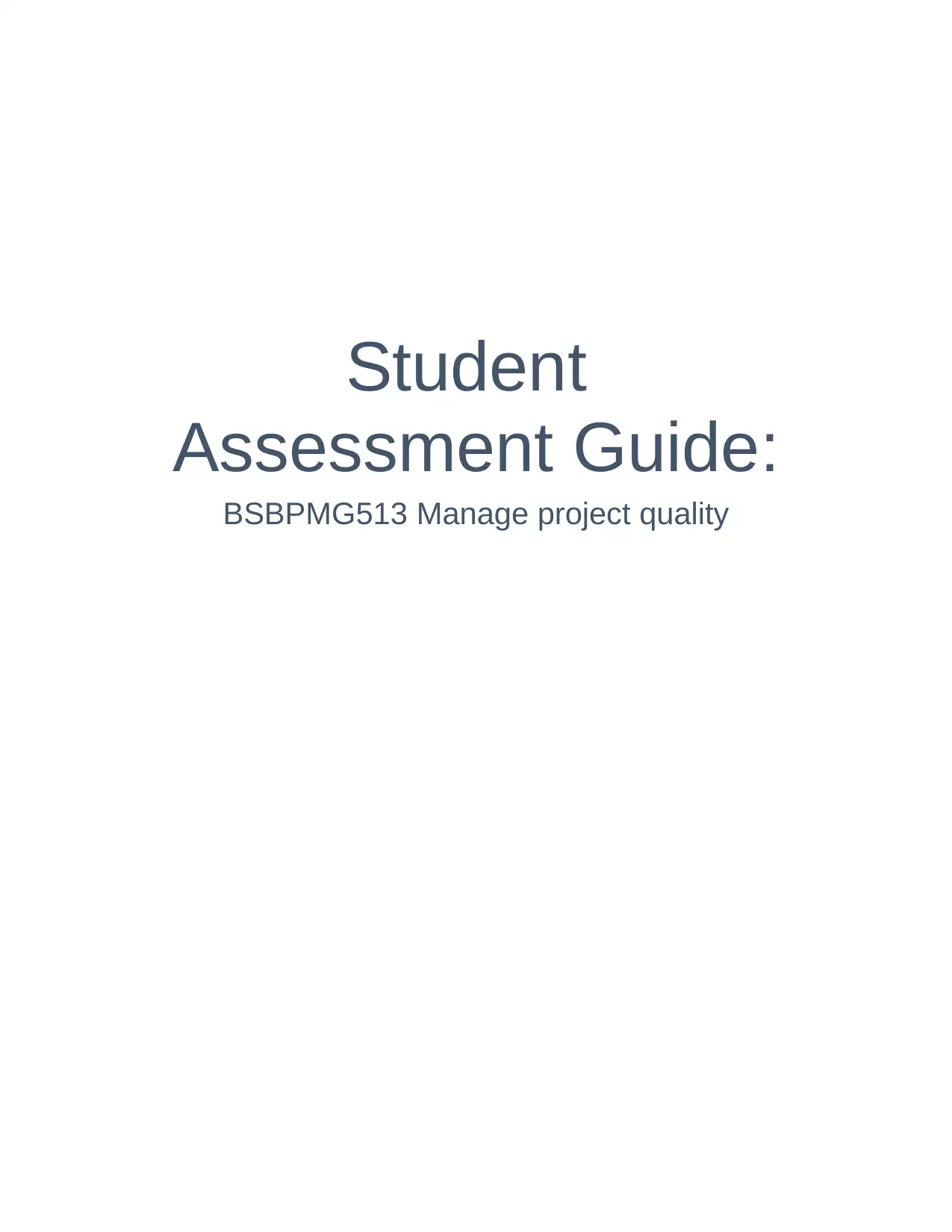
Student
Assessment Guide:
BSBPMG513 Manage project quality
Assessment Guide:
BSBPMG513 Manage project quality
Paraphrase This Document
Need a fresh take? Get an instant paraphrase of this document with our AI Paraphraser
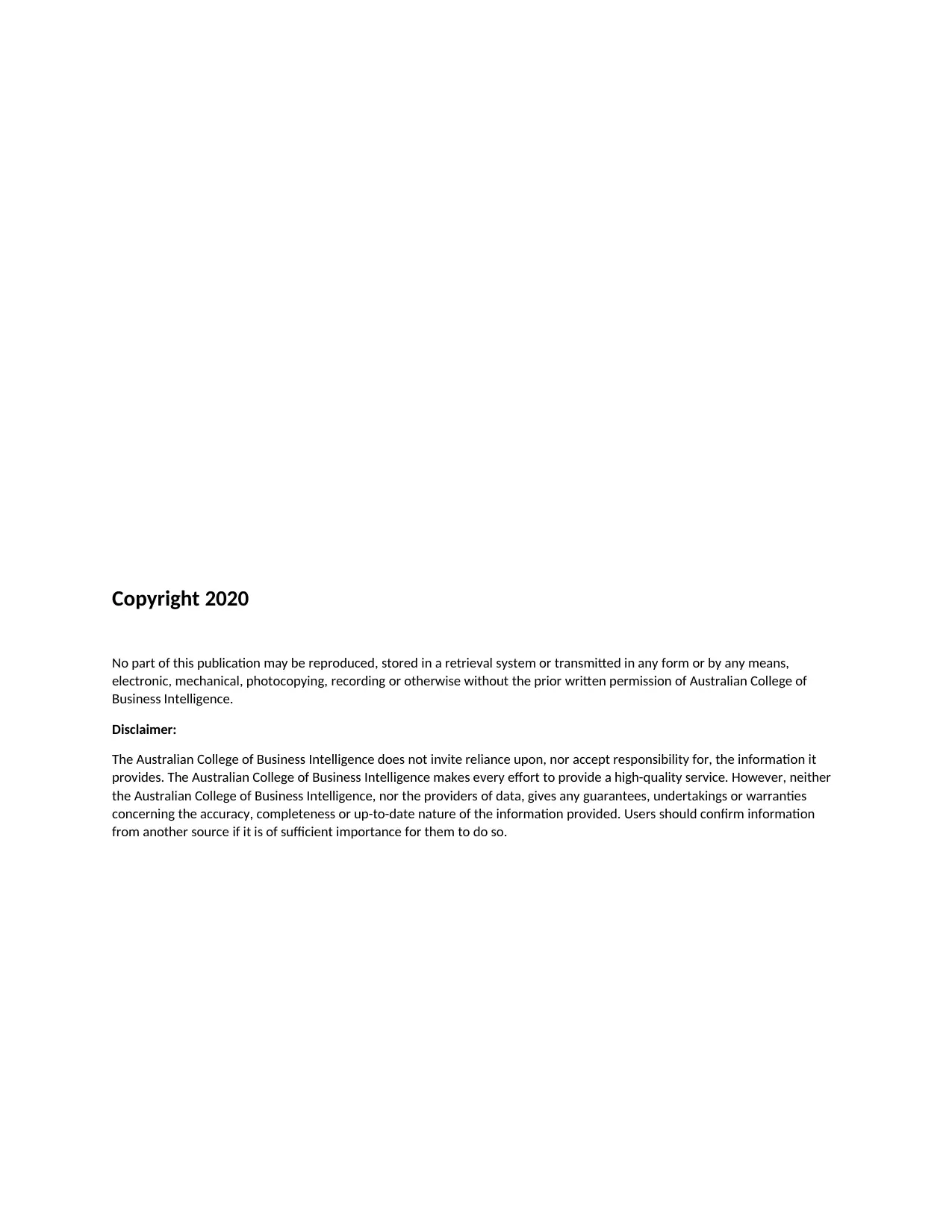
Copyright 2020
No part of this publication may be reproduced, stored in a retrieval system or transmitted in any form or by any means,
electronic, mechanical, photocopying, recording or otherwise without the prior written permission of Australian College of
Business Intelligence.
Disclaimer:
The Australian College of Business Intelligence does not invite reliance upon, nor accept responsibility for, the information it
provides. The Australian College of Business Intelligence makes every effort to provide a high-quality service. However, neither
the Australian College of Business Intelligence, nor the providers of data, gives any guarantees, undertakings or warranties
concerning the accuracy, completeness or up-to-date nature of the information provided. Users should confirm information
from another source if it is of sufficient importance for them to do so.
No part of this publication may be reproduced, stored in a retrieval system or transmitted in any form or by any means,
electronic, mechanical, photocopying, recording or otherwise without the prior written permission of Australian College of
Business Intelligence.
Disclaimer:
The Australian College of Business Intelligence does not invite reliance upon, nor accept responsibility for, the information it
provides. The Australian College of Business Intelligence makes every effort to provide a high-quality service. However, neither
the Australian College of Business Intelligence, nor the providers of data, gives any guarantees, undertakings or warranties
concerning the accuracy, completeness or up-to-date nature of the information provided. Users should confirm information
from another source if it is of sufficient importance for them to do so.

Contents
1. Assessment Information......................................................................................................5
A. Purpose of assessment........................................................................................................................5
B. Competencies being assessed.............................................................................................................5
C. What you are required to do...............................................................................................................6
Assessment Task 1 ‒ Questioning..........................................................................................................................6
Assessment Task 2 ‒ Simulated workplace scenario.............................................................................................6
Assessment Task 3 ‒ Project..................................................................................................................................7
D. Adjustment and Support.....................................................................................................................8
E. Assessment submission.......................................................................................................................8
F. Assessment results and feedback........................................................................................................9
G. Technical tools for completing this assessment................................................................................10
2. Assessment Coversheet .....................................................................................................11
3. Assessment Requirements.................................................................................................12
A. Task 1 – Questioning
i. Instructions for students.....................................................................................................................12
ii. Questions...........................................................................................................................................12
B. Task 2 – Simulated Workplace Scenario
i. Instructions for students.....................................................................................................................16
ii. Scenario.............................................................................................................................................16
iii. Questions..........................................................................................................................................19
C. Task 3 – Project
i. Instructions for students.....................................................................................................................22
ii. Questions
...............................................................................................................................................................22
..............................................................................................................................................................22
1. Assessment Information......................................................................................................5
A. Purpose of assessment........................................................................................................................5
B. Competencies being assessed.............................................................................................................5
C. What you are required to do...............................................................................................................6
Assessment Task 1 ‒ Questioning..........................................................................................................................6
Assessment Task 2 ‒ Simulated workplace scenario.............................................................................................6
Assessment Task 3 ‒ Project..................................................................................................................................7
D. Adjustment and Support.....................................................................................................................8
E. Assessment submission.......................................................................................................................8
F. Assessment results and feedback........................................................................................................9
G. Technical tools for completing this assessment................................................................................10
2. Assessment Coversheet .....................................................................................................11
3. Assessment Requirements.................................................................................................12
A. Task 1 – Questioning
i. Instructions for students.....................................................................................................................12
ii. Questions...........................................................................................................................................12
B. Task 2 – Simulated Workplace Scenario
i. Instructions for students.....................................................................................................................16
ii. Scenario.............................................................................................................................................16
iii. Questions..........................................................................................................................................19
C. Task 3 – Project
i. Instructions for students.....................................................................................................................22
ii. Questions
...............................................................................................................................................................22
..............................................................................................................................................................22
⊘ This is a preview!⊘
Do you want full access?
Subscribe today to unlock all pages.

Trusted by 1+ million students worldwide
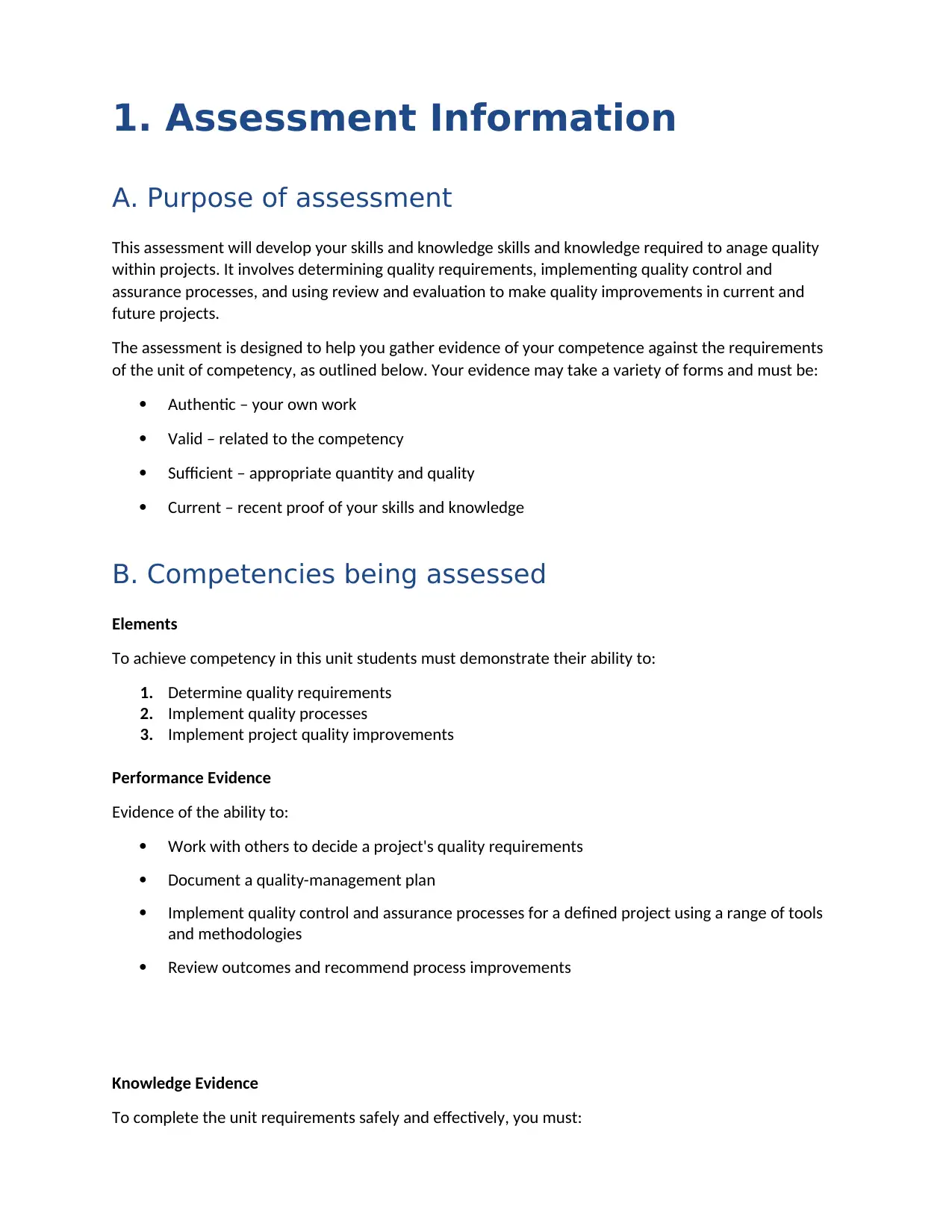
1. Assessment Information
A. Purpose of assessment
This assessment will develop your skills and knowledge skills and knowledge required to anage quality
within projects. It involves determining quality requirements, implementing quality control and
assurance processes, and using review and evaluation to make quality improvements in current and
future projects.
The assessment is designed to help you gather evidence of your competence against the requirements
of the unit of competency, as outlined below. Your evidence may take a variety of forms and must be:
Authentic – your own work
Valid – related to the competency
Sufficient – appropriate quantity and quality
Current – recent proof of your skills and knowledge
B. Competencies being assessed
Elements
To achieve competency in this unit students must demonstrate their ability to:
1. Determine quality requirements
2. Implement quality processes
3. Implement project quality improvements
Performance Evidence
Evidence of the ability to:
Work with others to decide a project's quality requirements
Document a quality-management plan
Implement quality control and assurance processes for a defined project using a range of tools
and methodologies
Review outcomes and recommend process improvements
Knowledge Evidence
To complete the unit requirements safely and effectively, you must:
A. Purpose of assessment
This assessment will develop your skills and knowledge skills and knowledge required to anage quality
within projects. It involves determining quality requirements, implementing quality control and
assurance processes, and using review and evaluation to make quality improvements in current and
future projects.
The assessment is designed to help you gather evidence of your competence against the requirements
of the unit of competency, as outlined below. Your evidence may take a variety of forms and must be:
Authentic – your own work
Valid – related to the competency
Sufficient – appropriate quantity and quality
Current – recent proof of your skills and knowledge
B. Competencies being assessed
Elements
To achieve competency in this unit students must demonstrate their ability to:
1. Determine quality requirements
2. Implement quality processes
3. Implement project quality improvements
Performance Evidence
Evidence of the ability to:
Work with others to decide a project's quality requirements
Document a quality-management plan
Implement quality control and assurance processes for a defined project using a range of tools
and methodologies
Review outcomes and recommend process improvements
Knowledge Evidence
To complete the unit requirements safely and effectively, you must:
Paraphrase This Document
Need a fresh take? Get an instant paraphrase of this document with our AI Paraphraser

Explain quality management theory
Explain relevant standards that apply in the organisation
Describe quality assurance and control techniques, key tools and methodologies
Describe roles and responsibilities of quality management personnel
Explain methods for managing continuous improvement
For further information on the competencies of this unit, please refer to:
https://training.gov.au/Training/Details/BSBPMG513
C. What you are required to do
This assessment requires you to answer all questions within each Assessment Task and be assessed as
“Satisfactory” in each to gain competency in BSBPMG513 Manage Project Quality.
Assessment Task 1 ‒ Questioning
You are required to respond to a series of short-answer questions to demonstrate your knowledge
across key concepts and variables involved in managing project quality.
Assessment Task 2 ‒ Simulated workplace scenario
You are required to develop a Quality Management Plan in response to a scenario, using the templates
provided. This assessment task requires you to construct and complete a Quality Management Plan for a
simulated workplace project.
Assessment Task 3 ‒ Project
You are required to review the activities you have planned and would conduct to effectively manage
project quality. In this Assessment Task you will be required to update key quality management
documents and write a Lessons Learned Report.
For further details, please refer to the “Assessment Requirements” section of this document.
Assessment resources
To enable you to complete this assessment, the following documents have been provided in the unit
course page on Moodle: BSBPMG513 Manage Project Quality Learner Guide
BSBPMG513 Manage Project Quality PowerPoint Slides
PMBOK 5th edition, chapter 8 “Project Quality Management”, pages 227 - 254
Explain relevant standards that apply in the organisation
Describe quality assurance and control techniques, key tools and methodologies
Describe roles and responsibilities of quality management personnel
Explain methods for managing continuous improvement
For further information on the competencies of this unit, please refer to:
https://training.gov.au/Training/Details/BSBPMG513
C. What you are required to do
This assessment requires you to answer all questions within each Assessment Task and be assessed as
“Satisfactory” in each to gain competency in BSBPMG513 Manage Project Quality.
Assessment Task 1 ‒ Questioning
You are required to respond to a series of short-answer questions to demonstrate your knowledge
across key concepts and variables involved in managing project quality.
Assessment Task 2 ‒ Simulated workplace scenario
You are required to develop a Quality Management Plan in response to a scenario, using the templates
provided. This assessment task requires you to construct and complete a Quality Management Plan for a
simulated workplace project.
Assessment Task 3 ‒ Project
You are required to review the activities you have planned and would conduct to effectively manage
project quality. In this Assessment Task you will be required to update key quality management
documents and write a Lessons Learned Report.
For further details, please refer to the “Assessment Requirements” section of this document.
Assessment resources
To enable you to complete this assessment, the following documents have been provided in the unit
course page on Moodle: BSBPMG513 Manage Project Quality Learner Guide
BSBPMG513 Manage Project Quality PowerPoint Slides
PMBOK 5th edition, chapter 8 “Project Quality Management”, pages 227 - 254
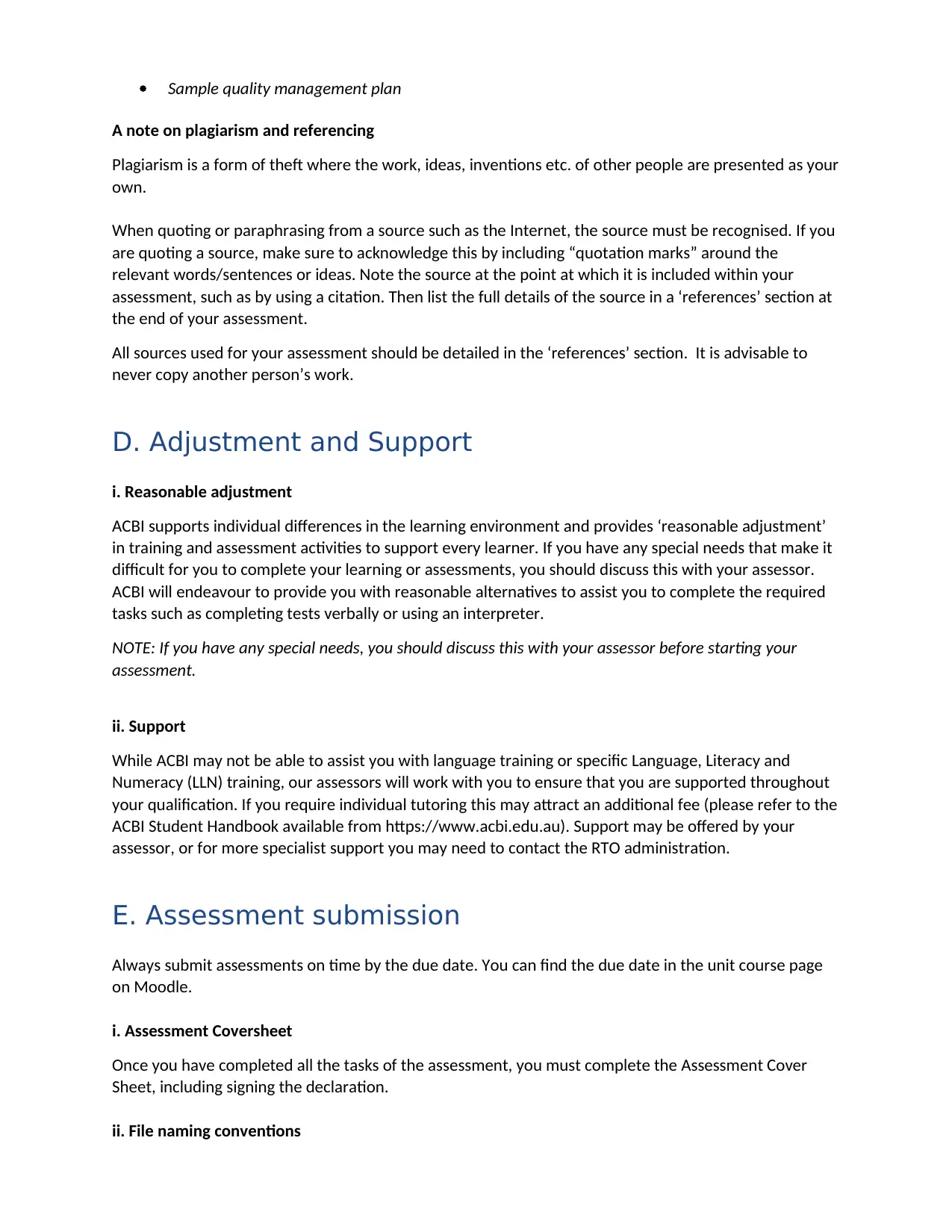
Sample quality management plan
A note on plagiarism and referencing
Plagiarism is a form of theft where the work, ideas, inventions etc. of other people are presented as your
own.
When quoting or paraphrasing from a source such as the Internet, the source must be recognised. If you
are quoting a source, make sure to acknowledge this by including “quotation marks” around the
relevant words/sentences or ideas. Note the source at the point at which it is included within your
assessment, such as by using a citation. Then list the full details of the source in a ‘references’ section at
the end of your assessment.
All sources used for your assessment should be detailed in the ‘references’ section. It is advisable to
never copy another person’s work.
D. Adjustment and Support
i. Reasonable adjustment
ACBI supports individual differences in the learning environment and provides ‘reasonable adjustment’
in training and assessment activities to support every learner. If you have any special needs that make it
difficult for you to complete your learning or assessments, you should discuss this with your assessor.
ACBI will endeavour to provide you with reasonable alternatives to assist you to complete the required
tasks such as completing tests verbally or using an interpreter.
NOTE: If you have any special needs, you should discuss this with your assessor before starting your
assessment.
ii. Support
While ACBI may not be able to assist you with language training or specific Language, Literacy and
Numeracy (LLN) training, our assessors will work with you to ensure that you are supported throughout
your qualification. If you require individual tutoring this may attract an additional fee (please refer to the
ACBI Student Handbook available from https://www.acbi.edu.au). Support may be offered by your
assessor, or for more specialist support you may need to contact the RTO administration.
E. Assessment submission
Always submit assessments on time by the due date. You can find the due date in the unit course page
on Moodle.
i. Assessment Coversheet
Once you have completed all the tasks of the assessment, you must complete the Assessment Cover
Sheet, including signing the declaration.
ii. File naming conventions
A note on plagiarism and referencing
Plagiarism is a form of theft where the work, ideas, inventions etc. of other people are presented as your
own.
When quoting or paraphrasing from a source such as the Internet, the source must be recognised. If you
are quoting a source, make sure to acknowledge this by including “quotation marks” around the
relevant words/sentences or ideas. Note the source at the point at which it is included within your
assessment, such as by using a citation. Then list the full details of the source in a ‘references’ section at
the end of your assessment.
All sources used for your assessment should be detailed in the ‘references’ section. It is advisable to
never copy another person’s work.
D. Adjustment and Support
i. Reasonable adjustment
ACBI supports individual differences in the learning environment and provides ‘reasonable adjustment’
in training and assessment activities to support every learner. If you have any special needs that make it
difficult for you to complete your learning or assessments, you should discuss this with your assessor.
ACBI will endeavour to provide you with reasonable alternatives to assist you to complete the required
tasks such as completing tests verbally or using an interpreter.
NOTE: If you have any special needs, you should discuss this with your assessor before starting your
assessment.
ii. Support
While ACBI may not be able to assist you with language training or specific Language, Literacy and
Numeracy (LLN) training, our assessors will work with you to ensure that you are supported throughout
your qualification. If you require individual tutoring this may attract an additional fee (please refer to the
ACBI Student Handbook available from https://www.acbi.edu.au). Support may be offered by your
assessor, or for more specialist support you may need to contact the RTO administration.
E. Assessment submission
Always submit assessments on time by the due date. You can find the due date in the unit course page
on Moodle.
i. Assessment Coversheet
Once you have completed all the tasks of the assessment, you must complete the Assessment Cover
Sheet, including signing the declaration.
ii. File naming conventions
⊘ This is a preview!⊘
Do you want full access?
Subscribe today to unlock all pages.

Trusted by 1+ million students worldwide
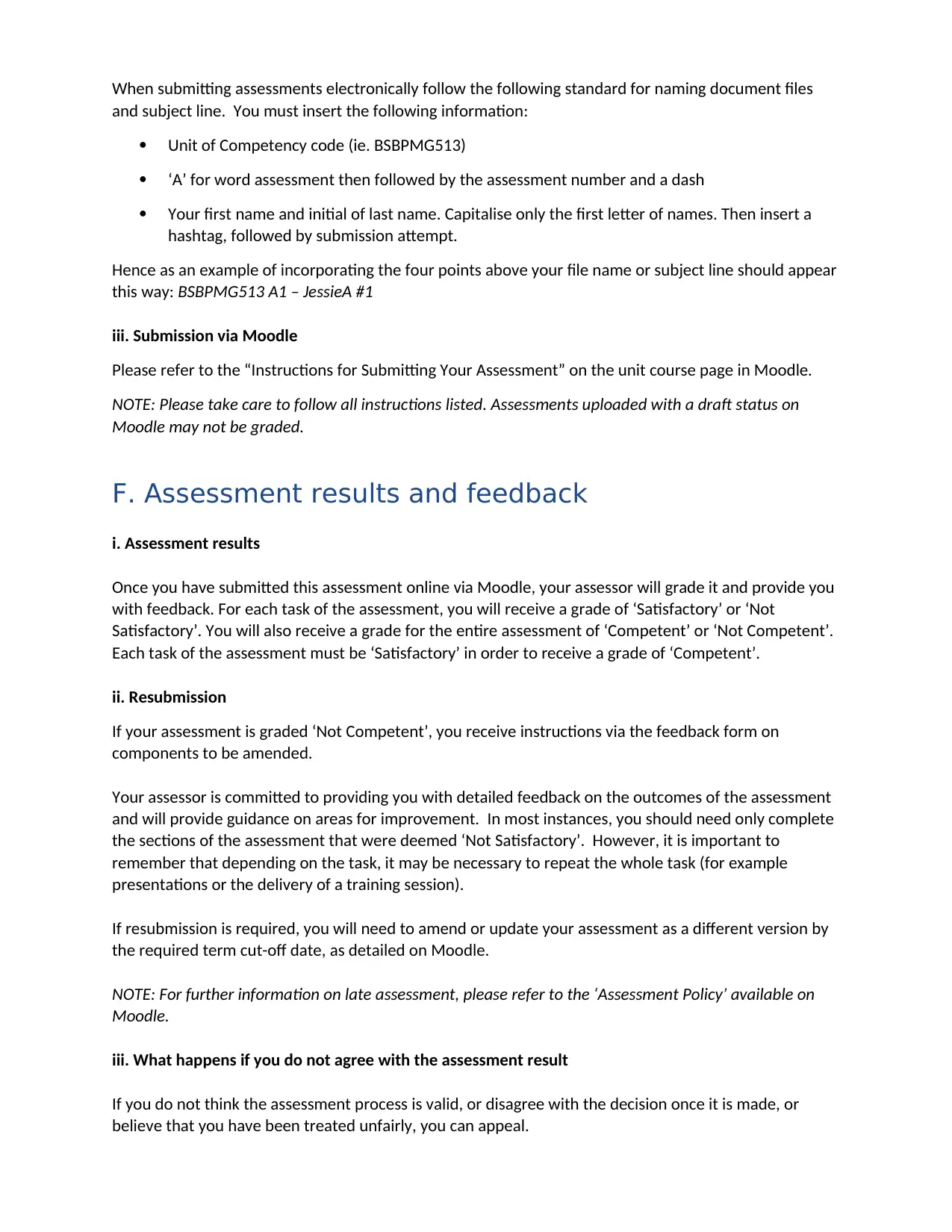
When submitting assessments electronically follow the following standard for naming document files
and subject line. You must insert the following information:
Unit of Competency code (ie. BSBPMG513)
‘A’ for word assessment then followed by the assessment number and a dash
Your first name and initial of last name. Capitalise only the first letter of names. Then insert a
hashtag, followed by submission attempt.
Hence as an example of incorporating the four points above your file name or subject line should appear
this way: BSBPMG513 A1 – JessieA #1
iii. Submission via Moodle
Please refer to the “Instructions for Submitting Your Assessment” on the unit course page in Moodle.
NOTE: Please take care to follow all instructions listed. Assessments uploaded with a draft status on
Moodle may not be graded.
F. Assessment results and feedback
i. Assessment results
Once you have submitted this assessment online via Moodle, your assessor will grade it and provide you
with feedback. For each task of the assessment, you will receive a grade of ‘Satisfactory’ or ‘Not
Satisfactory’. You will also receive a grade for the entire assessment of ‘Competent’ or ‘Not Competent’.
Each task of the assessment must be ‘Satisfactory’ in order to receive a grade of ‘Competent’.
ii. Resubmission
If your assessment is graded ‘Not Competent’, you receive instructions via the feedback form on
components to be amended.
Your assessor is committed to providing you with detailed feedback on the outcomes of the assessment
and will provide guidance on areas for improvement. In most instances, you should need only complete
the sections of the assessment that were deemed ‘Not Satisfactory’. However, it is important to
remember that depending on the task, it may be necessary to repeat the whole task (for example
presentations or the delivery of a training session).
If resubmission is required, you will need to amend or update your assessment as a different version by
the required term cut-off date, as detailed on Moodle.
NOTE: For further information on late assessment, please refer to the ‘Assessment Policy’ available on
Moodle.
iii. What happens if you do not agree with the assessment result
If you do not think the assessment process is valid, or disagree with the decision once it is made, or
believe that you have been treated unfairly, you can appeal.
and subject line. You must insert the following information:
Unit of Competency code (ie. BSBPMG513)
‘A’ for word assessment then followed by the assessment number and a dash
Your first name and initial of last name. Capitalise only the first letter of names. Then insert a
hashtag, followed by submission attempt.
Hence as an example of incorporating the four points above your file name or subject line should appear
this way: BSBPMG513 A1 – JessieA #1
iii. Submission via Moodle
Please refer to the “Instructions for Submitting Your Assessment” on the unit course page in Moodle.
NOTE: Please take care to follow all instructions listed. Assessments uploaded with a draft status on
Moodle may not be graded.
F. Assessment results and feedback
i. Assessment results
Once you have submitted this assessment online via Moodle, your assessor will grade it and provide you
with feedback. For each task of the assessment, you will receive a grade of ‘Satisfactory’ or ‘Not
Satisfactory’. You will also receive a grade for the entire assessment of ‘Competent’ or ‘Not Competent’.
Each task of the assessment must be ‘Satisfactory’ in order to receive a grade of ‘Competent’.
ii. Resubmission
If your assessment is graded ‘Not Competent’, you receive instructions via the feedback form on
components to be amended.
Your assessor is committed to providing you with detailed feedback on the outcomes of the assessment
and will provide guidance on areas for improvement. In most instances, you should need only complete
the sections of the assessment that were deemed ‘Not Satisfactory’. However, it is important to
remember that depending on the task, it may be necessary to repeat the whole task (for example
presentations or the delivery of a training session).
If resubmission is required, you will need to amend or update your assessment as a different version by
the required term cut-off date, as detailed on Moodle.
NOTE: For further information on late assessment, please refer to the ‘Assessment Policy’ available on
Moodle.
iii. What happens if you do not agree with the assessment result
If you do not think the assessment process is valid, or disagree with the decision once it is made, or
believe that you have been treated unfairly, you can appeal.
Paraphrase This Document
Need a fresh take? Get an instant paraphrase of this document with our AI Paraphraser
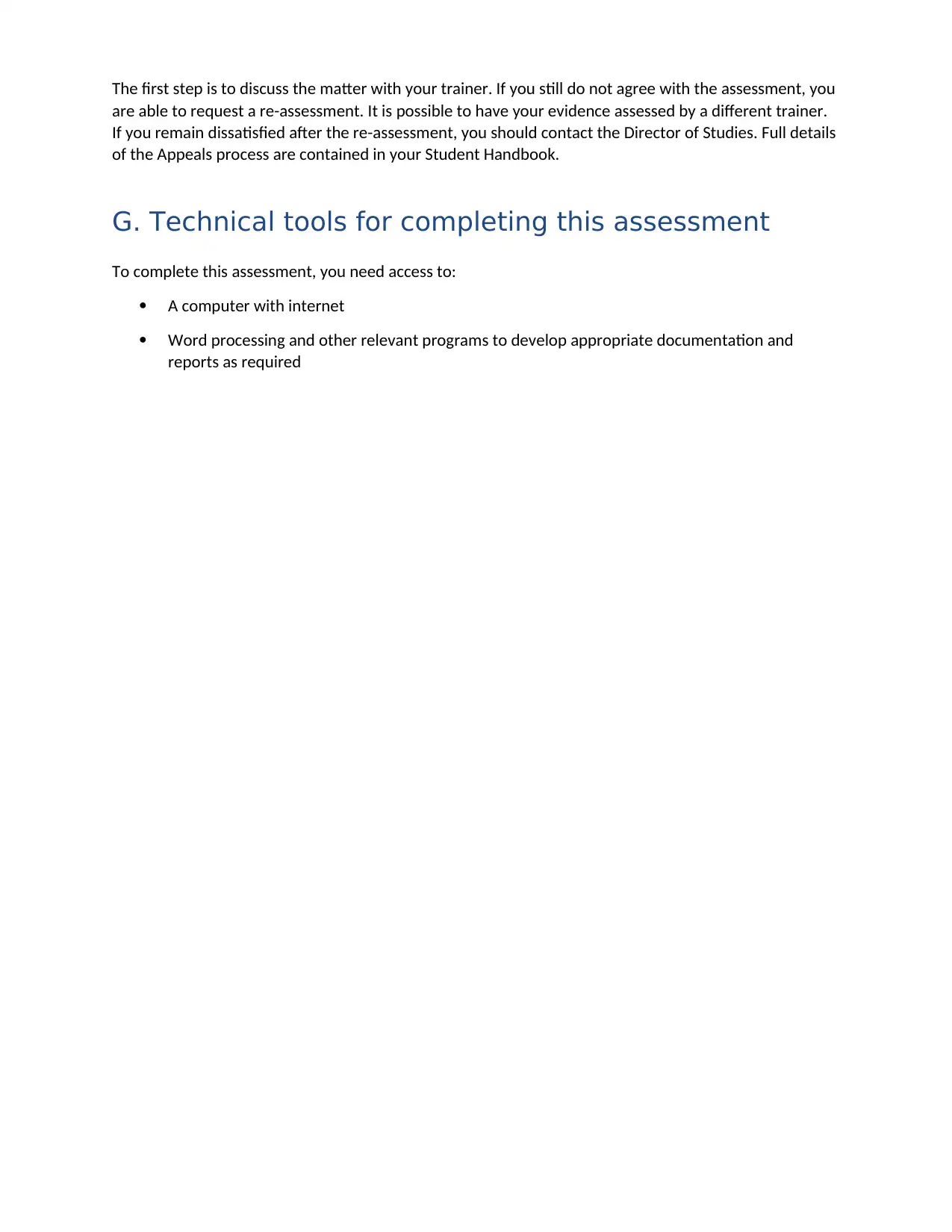
The first step is to discuss the matter with your trainer. If you still do not agree with the assessment, you
are able to request a re-assessment. It is possible to have your evidence assessed by a different trainer.
If you remain dissatisfied after the re-assessment, you should contact the Director of Studies. Full details
of the Appeals process are contained in your Student Handbook.
G. Technical tools for completing this assessment
To complete this assessment, you need access to:
A computer with internet
Word processing and other relevant programs to develop appropriate documentation and
reports as required
are able to request a re-assessment. It is possible to have your evidence assessed by a different trainer.
If you remain dissatisfied after the re-assessment, you should contact the Director of Studies. Full details
of the Appeals process are contained in your Student Handbook.
G. Technical tools for completing this assessment
To complete this assessment, you need access to:
A computer with internet
Word processing and other relevant programs to develop appropriate documentation and
reports as required
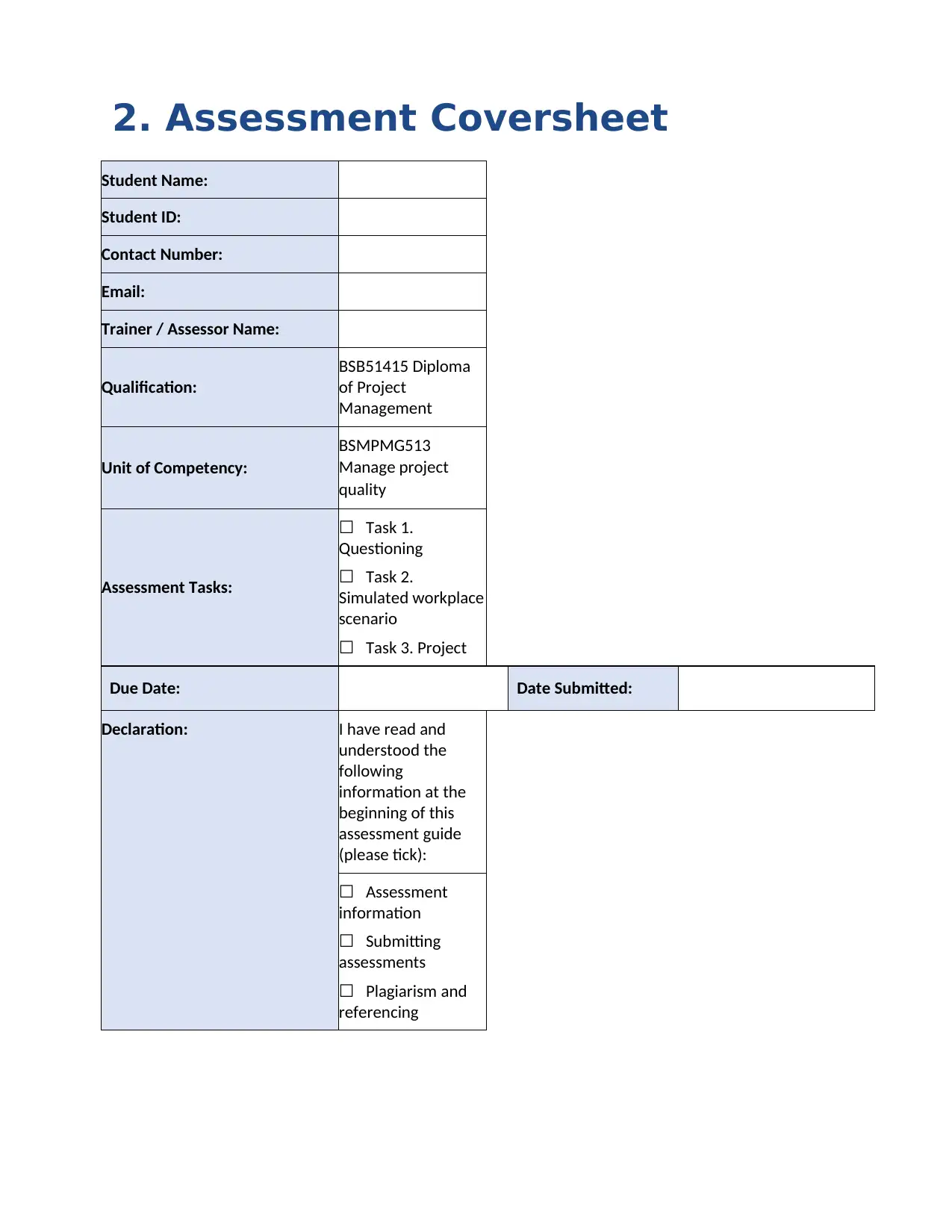
2. Assessment Coversheet
Student Name:
Student ID:
Contact Number:
Email:
Trainer / Assessor Name:
Qualification:
BSB51415 Diploma
of Project
Management
Unit of Competency:
BSMPMG513
Manage project
quality
Assessment Tasks:
☐ Task 1.
Questioning
☐ Task 2.
Simulated workplace
scenario
☐ Task 3. Project
Due Date: Date Submitted:
Declaration: I have read and
understood the
following
information at the
beginning of this
assessment guide
(please tick):
☐ Assessment
information
☐ Submitting
assessments
☐ Plagiarism and
referencing
Student Name:
Student ID:
Contact Number:
Email:
Trainer / Assessor Name:
Qualification:
BSB51415 Diploma
of Project
Management
Unit of Competency:
BSMPMG513
Manage project
quality
Assessment Tasks:
☐ Task 1.
Questioning
☐ Task 2.
Simulated workplace
scenario
☐ Task 3. Project
Due Date: Date Submitted:
Declaration: I have read and
understood the
following
information at the
beginning of this
assessment guide
(please tick):
☐ Assessment
information
☐ Submitting
assessments
☐ Plagiarism and
referencing
⊘ This is a preview!⊘
Do you want full access?
Subscribe today to unlock all pages.

Trusted by 1+ million students worldwide
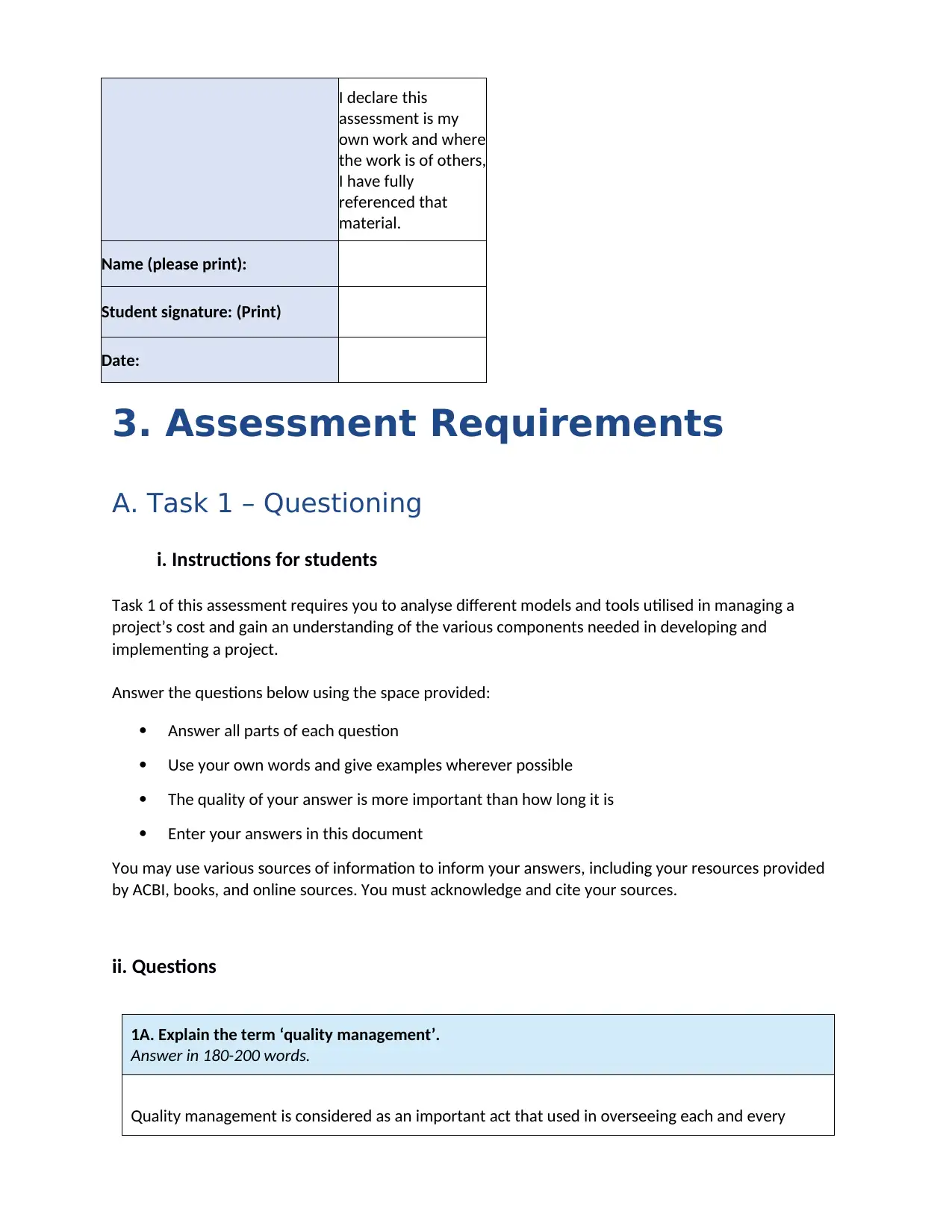
I declare this
assessment is my
own work and where
the work is of others,
I have fully
referenced that
material.
Name (please print):
Student signature: (Print)
Date:
3. Assessment Requirements
A. Task 1 – Questioning
i. Instructions for students
Task 1 of this assessment requires you to analyse different models and tools utilised in managing a
project’s cost and gain an understanding of the various components needed in developing and
implementing a project.
Answer the questions below using the space provided:
Answer all parts of each question
Use your own words and give examples wherever possible
The quality of your answer is more important than how long it is
Enter your answers in this document
You may use various sources of information to inform your answers, including your resources provided
by ACBI, books, and online sources. You must acknowledge and cite your sources.
ii. Questions
1A. Explain the term ‘quality management’.
Answer in 180-200 words.
Quality management is considered as an important act that used in overseeing each and every
assessment is my
own work and where
the work is of others,
I have fully
referenced that
material.
Name (please print):
Student signature: (Print)
Date:
3. Assessment Requirements
A. Task 1 – Questioning
i. Instructions for students
Task 1 of this assessment requires you to analyse different models and tools utilised in managing a
project’s cost and gain an understanding of the various components needed in developing and
implementing a project.
Answer the questions below using the space provided:
Answer all parts of each question
Use your own words and give examples wherever possible
The quality of your answer is more important than how long it is
Enter your answers in this document
You may use various sources of information to inform your answers, including your resources provided
by ACBI, books, and online sources. You must acknowledge and cite your sources.
ii. Questions
1A. Explain the term ‘quality management’.
Answer in 180-200 words.
Quality management is considered as an important act that used in overseeing each and every
Paraphrase This Document
Need a fresh take? Get an instant paraphrase of this document with our AI Paraphraser
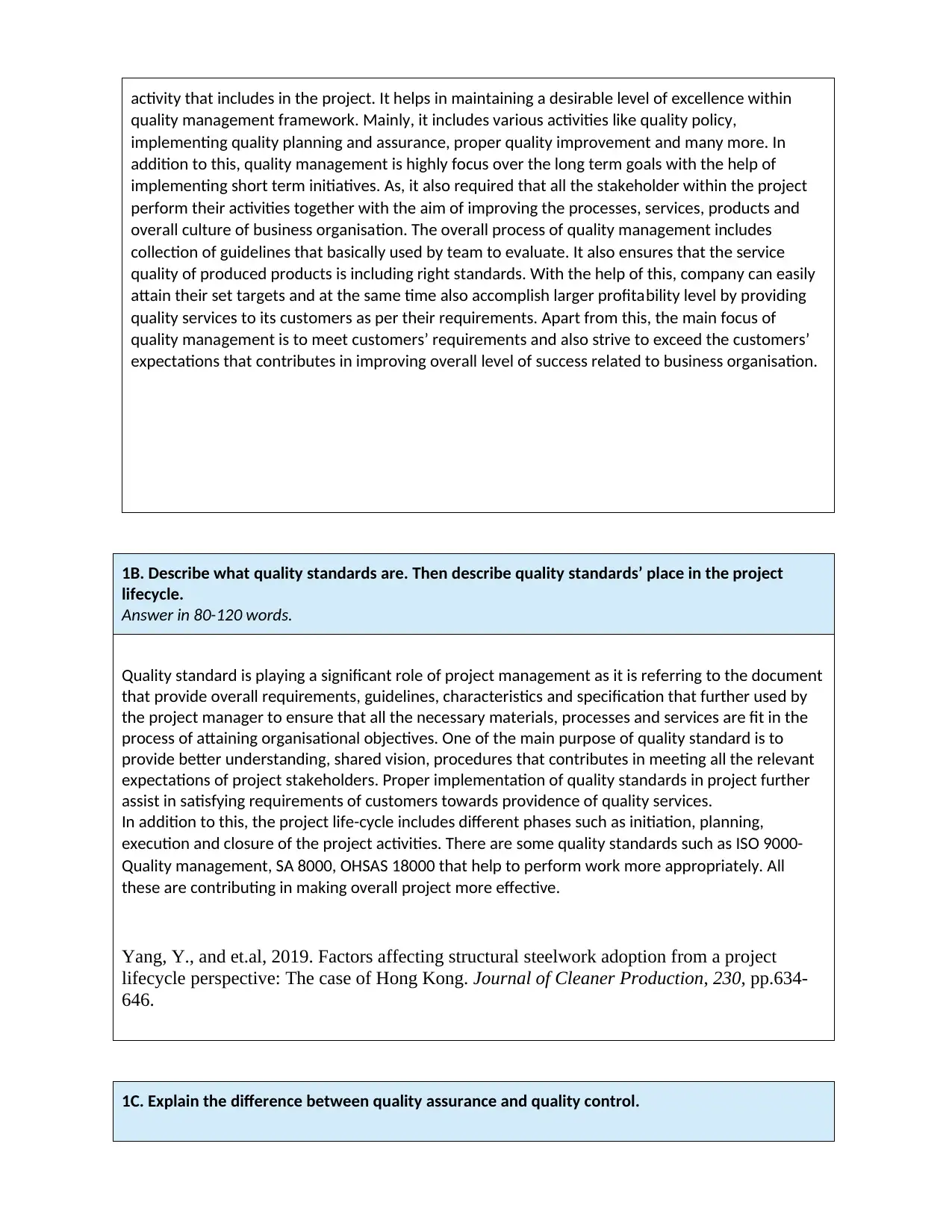
activity that includes in the project. It helps in maintaining a desirable level of excellence within
quality management framework. Mainly, it includes various activities like quality policy,
implementing quality planning and assurance, proper quality improvement and many more. In
addition to this, quality management is highly focus over the long term goals with the help of
implementing short term initiatives. As, it also required that all the stakeholder within the project
perform their activities together with the aim of improving the processes, services, products and
overall culture of business organisation. The overall process of quality management includes
collection of guidelines that basically used by team to evaluate. It also ensures that the service
quality of produced products is including right standards. With the help of this, company can easily
attain their set targets and at the same time also accomplish larger profitability level by providing
quality services to its customers as per their requirements. Apart from this, the main focus of
quality management is to meet customers’ requirements and also strive to exceed the customers’
expectations that contributes in improving overall level of success related to business organisation.
1B. Describe what quality standards are. Then describe quality standards’ place in the project
lifecycle.
Answer in 80-120 words.
Quality standard is playing a significant role of project management as it is referring to the document
that provide overall requirements, guidelines, characteristics and specification that further used by
the project manager to ensure that all the necessary materials, processes and services are fit in the
process of attaining organisational objectives. One of the main purpose of quality standard is to
provide better understanding, shared vision, procedures that contributes in meeting all the relevant
expectations of project stakeholders. Proper implementation of quality standards in project further
assist in satisfying requirements of customers towards providence of quality services.
In addition to this, the project life-cycle includes different phases such as initiation, planning,
execution and closure of the project activities. There are some quality standards such as ISO 9000-
Quality management, SA 8000, OHSAS 18000 that help to perform work more appropriately. All
these are contributing in making overall project more effective.
Yang, Y., and et.al, 2019. Factors affecting structural steelwork adoption from a project
lifecycle perspective: The case of Hong Kong. Journal of Cleaner Production, 230, pp.634-
646.
1C. Explain the difference between quality assurance and quality control.
quality management framework. Mainly, it includes various activities like quality policy,
implementing quality planning and assurance, proper quality improvement and many more. In
addition to this, quality management is highly focus over the long term goals with the help of
implementing short term initiatives. As, it also required that all the stakeholder within the project
perform their activities together with the aim of improving the processes, services, products and
overall culture of business organisation. The overall process of quality management includes
collection of guidelines that basically used by team to evaluate. It also ensures that the service
quality of produced products is including right standards. With the help of this, company can easily
attain their set targets and at the same time also accomplish larger profitability level by providing
quality services to its customers as per their requirements. Apart from this, the main focus of
quality management is to meet customers’ requirements and also strive to exceed the customers’
expectations that contributes in improving overall level of success related to business organisation.
1B. Describe what quality standards are. Then describe quality standards’ place in the project
lifecycle.
Answer in 80-120 words.
Quality standard is playing a significant role of project management as it is referring to the document
that provide overall requirements, guidelines, characteristics and specification that further used by
the project manager to ensure that all the necessary materials, processes and services are fit in the
process of attaining organisational objectives. One of the main purpose of quality standard is to
provide better understanding, shared vision, procedures that contributes in meeting all the relevant
expectations of project stakeholders. Proper implementation of quality standards in project further
assist in satisfying requirements of customers towards providence of quality services.
In addition to this, the project life-cycle includes different phases such as initiation, planning,
execution and closure of the project activities. There are some quality standards such as ISO 9000-
Quality management, SA 8000, OHSAS 18000 that help to perform work more appropriately. All
these are contributing in making overall project more effective.
Yang, Y., and et.al, 2019. Factors affecting structural steelwork adoption from a project
lifecycle perspective: The case of Hong Kong. Journal of Cleaner Production, 230, pp.634-
646.
1C. Explain the difference between quality assurance and quality control.
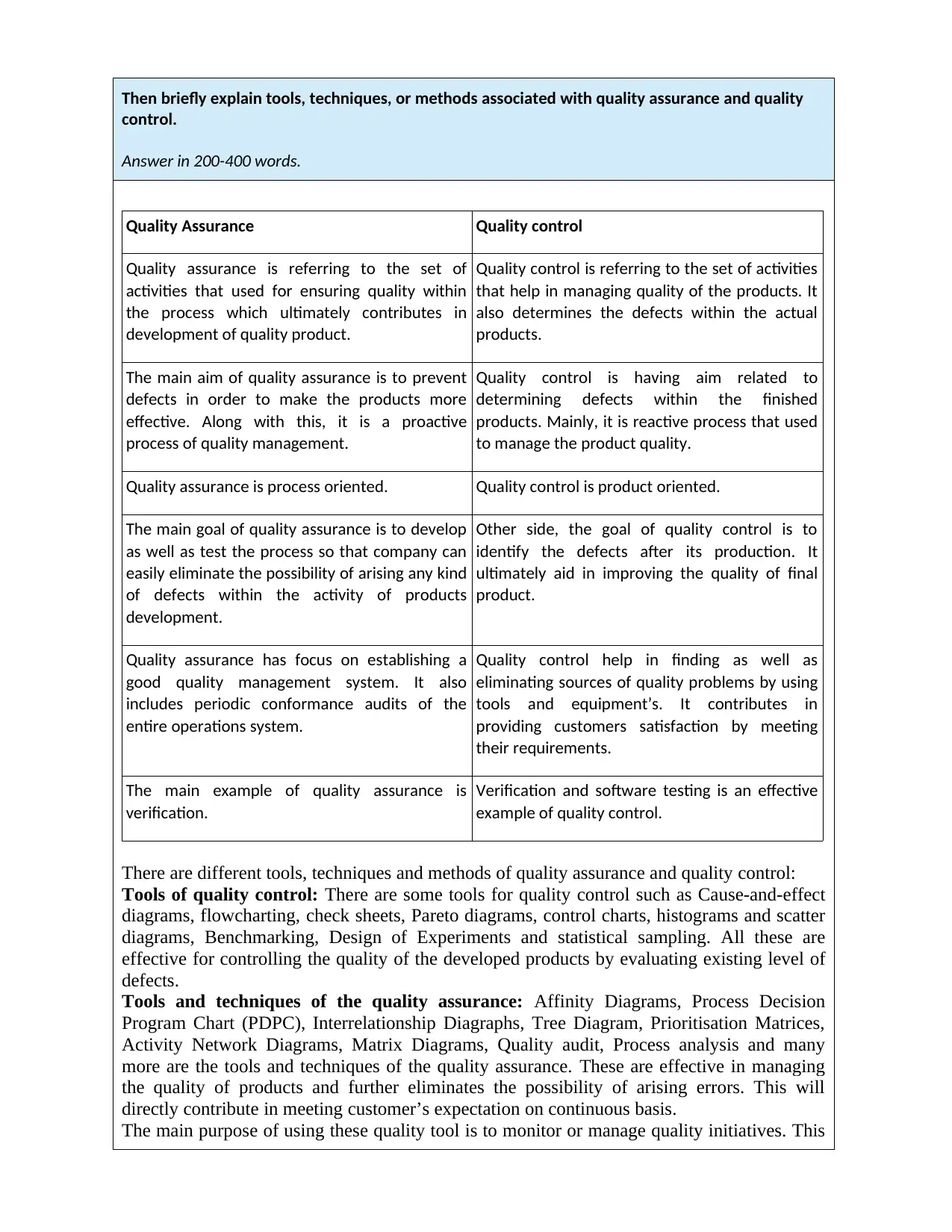
Then briefly explain tools, techniques, or methods associated with quality assurance and quality
control.
Answer in 200-400 words.
Quality Assurance Quality control
Quality assurance is referring to the set of
activities that used for ensuring quality within
the process which ultimately contributes in
development of quality product.
Quality control is referring to the set of activities
that help in managing quality of the products. It
also determines the defects within the actual
products.
The main aim of quality assurance is to prevent
defects in order to make the products more
effective. Along with this, it is a proactive
process of quality management.
Quality control is having aim related to
determining defects within the finished
products. Mainly, it is reactive process that used
to manage the product quality.
Quality assurance is process oriented. Quality control is product oriented.
The main goal of quality assurance is to develop
as well as test the process so that company can
easily eliminate the possibility of arising any kind
of defects within the activity of products
development.
Other side, the goal of quality control is to
identify the defects after its production. It
ultimately aid in improving the quality of final
product.
Quality assurance has focus on establishing a
good quality management system. It also
includes periodic conformance audits of the
entire operations system.
Quality control help in finding as well as
eliminating sources of quality problems by using
tools and equipment’s. It contributes in
providing customers satisfaction by meeting
their requirements.
The main example of quality assurance is
verification.
Verification and software testing is an effective
example of quality control.
There are different tools, techniques and methods of quality assurance and quality control:
Tools of quality control: There are some tools for quality control such as Cause-and-effect
diagrams, flowcharting, check sheets, Pareto diagrams, control charts, histograms and scatter
diagrams, Benchmarking, Design of Experiments and statistical sampling. All these are
effective for controlling the quality of the developed products by evaluating existing level of
defects.
Tools and techniques of the quality assurance: Affinity Diagrams, Process Decision
Program Chart (PDPC), Interrelationship Diagraphs, Tree Diagram, Prioritisation Matrices,
Activity Network Diagrams, Matrix Diagrams, Quality audit, Process analysis and many
more are the tools and techniques of the quality assurance. These are effective in managing
the quality of products and further eliminates the possibility of arising errors. This will
directly contribute in meeting customer’s expectation on continuous basis.
The main purpose of using these quality tool is to monitor or manage quality initiatives. This
control.
Answer in 200-400 words.
Quality Assurance Quality control
Quality assurance is referring to the set of
activities that used for ensuring quality within
the process which ultimately contributes in
development of quality product.
Quality control is referring to the set of activities
that help in managing quality of the products. It
also determines the defects within the actual
products.
The main aim of quality assurance is to prevent
defects in order to make the products more
effective. Along with this, it is a proactive
process of quality management.
Quality control is having aim related to
determining defects within the finished
products. Mainly, it is reactive process that used
to manage the product quality.
Quality assurance is process oriented. Quality control is product oriented.
The main goal of quality assurance is to develop
as well as test the process so that company can
easily eliminate the possibility of arising any kind
of defects within the activity of products
development.
Other side, the goal of quality control is to
identify the defects after its production. It
ultimately aid in improving the quality of final
product.
Quality assurance has focus on establishing a
good quality management system. It also
includes periodic conformance audits of the
entire operations system.
Quality control help in finding as well as
eliminating sources of quality problems by using
tools and equipment’s. It contributes in
providing customers satisfaction by meeting
their requirements.
The main example of quality assurance is
verification.
Verification and software testing is an effective
example of quality control.
There are different tools, techniques and methods of quality assurance and quality control:
Tools of quality control: There are some tools for quality control such as Cause-and-effect
diagrams, flowcharting, check sheets, Pareto diagrams, control charts, histograms and scatter
diagrams, Benchmarking, Design of Experiments and statistical sampling. All these are
effective for controlling the quality of the developed products by evaluating existing level of
defects.
Tools and techniques of the quality assurance: Affinity Diagrams, Process Decision
Program Chart (PDPC), Interrelationship Diagraphs, Tree Diagram, Prioritisation Matrices,
Activity Network Diagrams, Matrix Diagrams, Quality audit, Process analysis and many
more are the tools and techniques of the quality assurance. These are effective in managing
the quality of products and further eliminates the possibility of arising errors. This will
directly contribute in meeting customer’s expectation on continuous basis.
The main purpose of using these quality tool is to monitor or manage quality initiatives. This
⊘ This is a preview!⊘
Do you want full access?
Subscribe today to unlock all pages.

Trusted by 1+ million students worldwide
1 out of 29
Related Documents
Your All-in-One AI-Powered Toolkit for Academic Success.
+13062052269
info@desklib.com
Available 24*7 on WhatsApp / Email
![[object Object]](/_next/static/media/star-bottom.7253800d.svg)
Unlock your academic potential
Copyright © 2020–2025 A2Z Services. All Rights Reserved. Developed and managed by ZUCOL.





